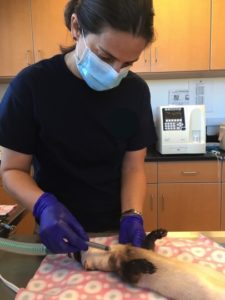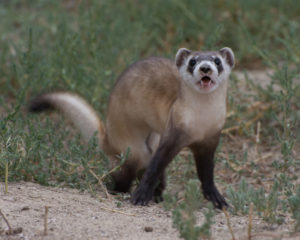 Colorado State University biology graduate student Debbie McCuen hopes her research will give the endangered black-footed ferret a fighting chance against plague. This disease – the same that caused Black Death pandemics in the Middle Ages – is partly to blame for the ferret’s decline and continues to stand in the way of its recovery.
Colorado State University biology graduate student Debbie McCuen hopes her research will give the endangered black-footed ferret a fighting chance against plague. This disease – the same that caused Black Death pandemics in the Middle Ages – is partly to blame for the ferret’s decline and continues to stand in the way of its recovery.
McCuen’s project, a collaboration between the U.S. Fish and Wildlife Service, Colorado Parks and Wildlife, and CSU, is researching an oral vaccine that will protect the ferret and help this prairie dog predator increase its numbers in the wild.
“If we can overcome plague, we can really be more successful in reestablishing self-sustaining wild populations,” McCuen said. Protecting the black-footed ferret is important because it helps keep prairie ecosystems in balance, she noted.
With a wild population of less than 500, the black-footed ferret is one of the most endangered mammals in North America due to habitat loss and non-native diseases like plague. The ferret was thought to be extinct until a small colony was discovered near Meeteetse, Wyoming in 1981. Today, descendants of those 18 remaining ferrets are bred in captivity at the National Black-Footed Ferret Conservation Center north of Fort Collins, and later released into the wild.

Vaccination elimination
Captive-born black-footed ferrets are given a plague vaccination shot before being released, but ferrets born in the wild must be captured and vaccinated by hand. McCuen said this process is time consuming and labor intensive – and is not ideal because each ferret must be captured again and given a booster shot one month later. She said that an edible vaccine would be much more efficient and would protect many more ferrets.
However, McCuen noted that developing such a vaccine isn’t as simple as turning the existing injectable version into an oral one because different vaccine delivery systems have different mechanisms of action on the immune system.
“It’s kind of like getting the nasal flu [vaccine] versus an injectable flu shot,” McCuen said. “You can’t necessarily use the same flu shot as the injectable version and just stick it up your nose and hope that it works.”
An oral plague vaccine for ferrets would also have to rely on a different vaccine vector, or a weakened virus that stimulates an immune system response. McCuen said that there are many different plague vaccine vectors to choose from, but one that seemed promising early in her project later failed to protect ferrets from plague. Now she has to start over by selecting a different vector and testing it on captive ferrets.
This whole process isn’t without precedent. Edible, peanut-butter-flavored oral plague vaccines have already proven successful for prairie dogs. McCuen said that among other things, a similar version for ferrets would have to be a different flavor.
“Since ferrets are not really into peanut butter, you’d probably want it ideally to be prairie dog flavored,” she said.
Black-footed background
McCuen graduated in 2001 from Northern Arizona University with a bachelor’s degree in zoology. But she didn’t develop an interest in ferrets until after she received her Doctor of Veterinary Medicine (DVM) from CSU in 2005. After practicing small animal medicine in Arizona, she returned to Fort Collins to work as a veterinarian at the Ferret Conservation Center, where she did minor surgeries and dental work on captive-born ferrets.
McCuen realized that she needed research experience in order to continue her career as a wildlife veterinarian, so she decided to come back to CSU for another graduate degree. After graduating, she hopes to return to the Ferret Conservation Center with expertise in both clinical work and research so she can continue helping with the ferret breeding program.
She’s motivated because black-footed ferrets are a key member of the prairie ecosystem. They are also interesting animals, she said.
“They are smaller than their main prey source, and the fact that they can take a prairie dog down that is bigger than them is pretty amazing” she said. “They’re ferocious and cute at the same time.”